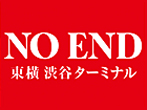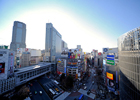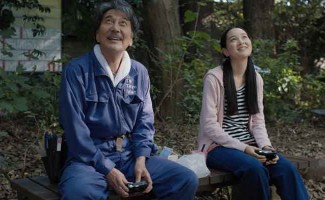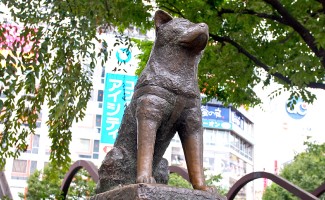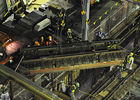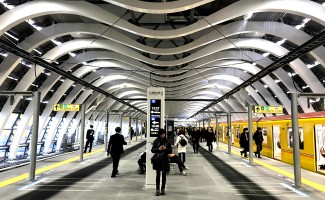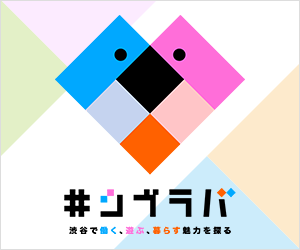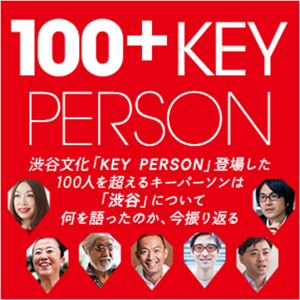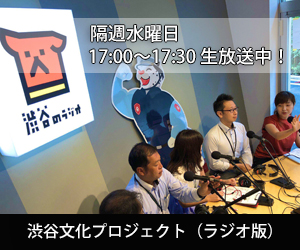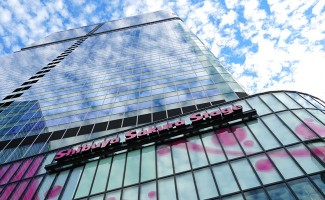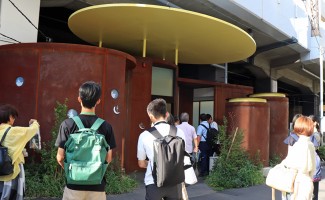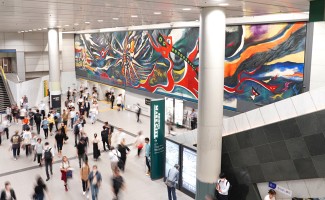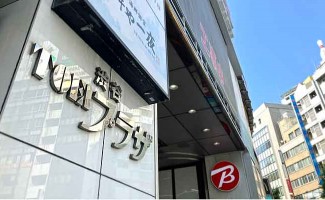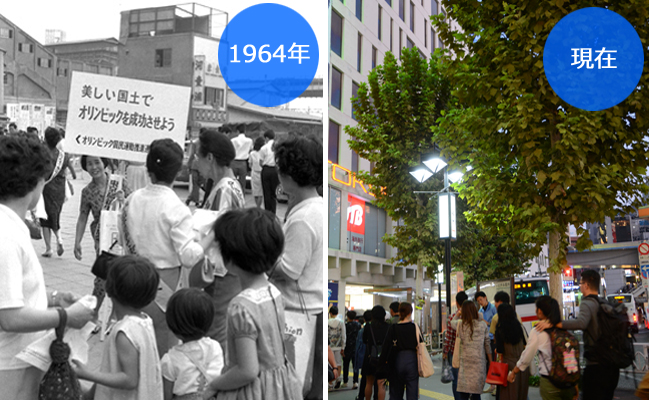
Shibuya on That Day Looking Backwards from the Past
Theme: "Olympic national campaign"
"Shibuya of that day" is a photo gallery that looks back on the history of the town from the photos of Shibuya in "Old" and "Now". When reviewing "old photos" again, you can see that various changes such as the streets of Shibuya at the time, the lives of people, fashion, etc. are connected to Shibuya today. In this project, I will compare the photos of Shibuya of "old" and "now", look back on the old steps of the city of Shibuya and want to find "new discoveries" and "awareness" from the old photos. This time, which is the 5th time, I would like to pay attention to the scenery of the "Olympic citizen movement" aiming for "beautiful national land" and "public morality improvement" ahead of holding the "1964 Tokyo Olympics".
According to the Japanese Government Tourism Board (JNTO), the number of foreign visitors to Japan in 2018 increased by 8.7% to 31.119 million. Since JNTO began collecting statistics, it is the largest number since the beginning of the statistics, and it seems that there are an increasing number of foreigners who are interested in Japanese culture etc. for 2020 Tokyo Olympic Games. When they came to Japan, the first thing to be surprised is that "the city is beautiful no matter where you go". There are few littering and there are so many voices that praise the height of Japanese morals. After the game such as the World Cup of Football, Japanese supporters who pick up garbage inside the stadium are often news, but from foreigners it is a very unbelievable sight.
So Japanese people have always been "public manners" good?
Before the Tokyo Olympics in 1964, it is said that Tokyo was a very dirty and stinky city. It is more than 20 years since the end of the war, most of the people can live to the fullest, an era when it can not afford to consider public morality. Household garbage was left on the street, smelled, and sputum (sputum) and spit were thrown away in there and it was a daily scenery that adults standing at ease without standing out of their eyes. It is unbelievable now, but from the generation that knows Japan a long time ago, it surely seems that "There was such a time."
However, it is too embarrassing as a country that "It is no longer after the war" by this and it is "a country that is going to join the international community by holding the Asia's first Olympics!" Therefore, Tokyo, the venue hosting the Olympic Games, declares the 10th of every month from 1962 to be the "Capital Beautification Day" and starts the "capital beautification campaign" such as cleaning and planting the town. A poly bucket that is now commonly used as a "garbage container" is one of the products popularized on the wave of this beautification campaign. Sekisui Chemical suggested a poly bucket with a lid "Poly Pale (product name)" with the advice from New York City Cleaning Bureau Director who came to visit. According to Sekisui Chemical's website, "With the minds of many municipalities and daily housewives who were in trouble with disposal of household garbage, polypairs became an unprecedented big hit product, and from each media" cleaning revolution "and It was admired. " It can be seen that it was a project X-like inventory that saved Tokyo where garbage was overflowing due to rapid urbanization.
<参考記事>
積水化学サイト街のゴミ問題を解決 プラスチック製ゴミ容器 ポリペール
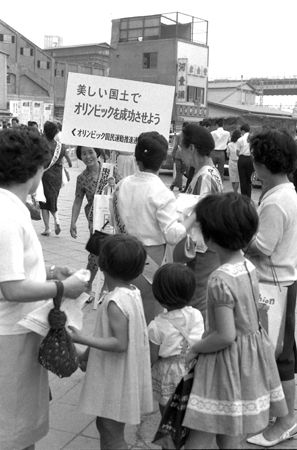 ▲ Olympic Beautification Movement (photographed in 1964) Photo provided = Shibuya Ward Regional Photo Preservation Association
▲ Olympic Beautification Movement (photographed in 1964) Photo provided = Shibuya Ward Regional Photo Preservation Association
Well, the introduction became longer, but this time the picture I picked up is one taken of the "capital beautification campaign" held in front of Shibuya station just before the 1964 Olympics. On the shoulder of a lady with a placard written as "Olympic citizen movement promotion federation to make the Olympic Games successful on a beautiful land area," the Tokyo Metropolitan New Life Movement Association "Tusuki is hanging. "Tokyo Metropolitan New Life Movement Association" was formed in 1957 in order to solve the citizens' familiar life issues such as daily living and health at the present "Association to Create Tomorrow Foundation Foundation Japan." In the "capital beautification campaign" aiming at improving public morality, it seems that he played a central role in welcoming visitors from overseas for the Olympics.
Ladies with placards are gathering ladies of the same age. It will surely be gathering in front of the station in order to do beautification campaign around Shibuya station this day. The time is also seen from hairstyles and fashion. Wakame chan who is participating with the lady (mother) in front of you, is the girls of the girls who are drifting, are they three sisters? Appearance like cute dress etc. Considering the time when children's ready-made garments are high and they are not so popular yet, it may be handmade by mothers.
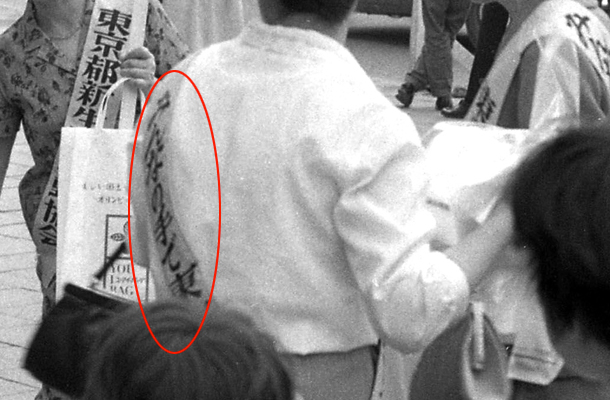 The beautification campaign which began in 1962 also expanded to large-scale citizens' total movements such as town councils, women's associations, elementary and junior high school students under the slogan "clean everyone's hands with Tokyo" during the Olympic year. Especially exercise seems to have been more active in Shibuya Ward, which has players' villages and Yoyogi stadiums in the current Yoyogi Park (formerly Washington Heights) than other areas.
The beautification campaign which began in 1962 also expanded to large-scale citizens' total movements such as town councils, women's associations, elementary and junior high school students under the slogan "clean everyone's hands with Tokyo" during the Olympic year. Especially exercise seems to have been more active in Shibuya Ward, which has players' villages and Yoyogi stadiums in the current Yoyogi Park (formerly Washington Heights) than other areas.
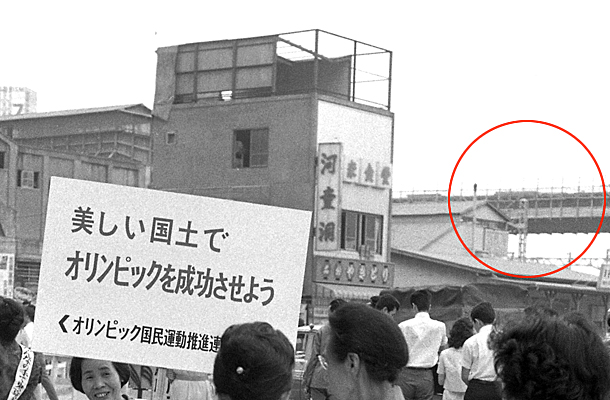 Where is the shooting location? If you look closely at the upper right of the photo, you can see that something like "bridge" extends straight from the right side of the mass diner called "Kappa dong." It is "Capital high speed" under construction work. "No. 3 Shibuya Line" was opened only 9 days before the opening of the Olympics. Successful construction was underway in the quite difficult construction period for the Olympics. It was about time when the construction was in the morning. Inferring from the position where the capital high speed can be seen, it is the current Shibuya station west exit.
Where is the shooting location? If you look closely at the upper right of the photo, you can see that something like "bridge" extends straight from the right side of the mass diner called "Kappa dong." It is "Capital high speed" under construction work. "No. 3 Shibuya Line" was opened only 9 days before the opening of the Olympics. Successful construction was underway in the quite difficult construction period for the Olympics. It was about time when the construction was in the morning. Inferring from the position where the capital high speed can be seen, it is the current Shibuya station west exit.
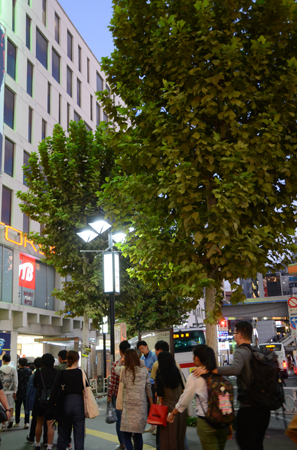 ▲ Shooting on October 9, 2017 (Photographer: Yutaka Sato)
▲ Shooting on October 9, 2017 (Photographer: Yutaka Sato)
Compare this with the current picture. In the background of the current photograph is "Tokyu Toyoko shop south wing" (1970 expanded construction), but at that time "Tokyu Toyoko Store South Building", too, "Tokyu Plaza Shibuya" (1965-2015) opposite that yet There was a space with good visibility in front of the station.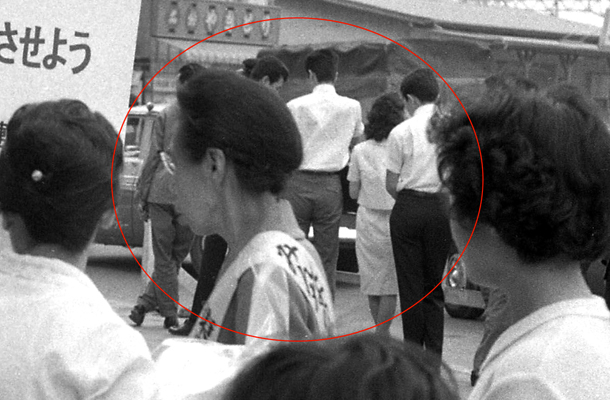 In the old picture, around the right rear of the ladies, there is a line of people waiting for a taxi or a bus. Likewise in the current picture you can also see the bus rotary in the backwards, which shows that the landscape of the town has not changed greatly around this time.
In the old picture, around the right rear of the ladies, there is a line of people waiting for a taxi or a bus. Likewise in the current picture you can also see the bus rotary in the backwards, which shows that the landscape of the town has not changed greatly around this time.
Well today, the beautification consciousness of the Japanese who is acclaimed from the world can be said to be the gift of the "capital beautification campaign" carried out at the citizen's total in the last meeting. Of course, it seems that there is no doubt that the consciousness of the Japanese people's mind has further increased with the success of the Olympics, although the "hospitality heart" wanting people to be pleased.
According to Mr. Yutaka Sato, a cameraman who knows about the time, we are cooperating with providing photographs every time, the river disappears rapidly from Tokyo on the occasion of the last Olympics and the river disappeared in Shibuya as well . At that time, the sewage system was not fully equipped and the domestic wastewater also flowed into the river in Shibuya, and when it got hot it got stinky and it became the place of generation of flies and mosquitoes. It seems that the river has disappeared because neighborhood residents requested lid (lid) from the viewpoint of hygiene and sanitation. In recent years, many people negatively say that the river has disappeared, according to Mr. Sato, "It was a ruthless problem in the day when we lived in our daily lives." Over the half-century time, sewage facilities were in place, and in the autumn of last year a plan to stream a clear stream to a part of the Shibuya River adjacent to Shibuya SHIBUYA STREAM was completed. "It is a river that shows a strong entertainment, unlike the old river, but I would like to see a revival of the river that will convey the history of Shibuya in the future".
Now that the holding of the Olympic Games in 2020 is coming close, we may have something to learn a little from the approach at the time of the last meeting.
<Back number>
-"Shibuya of that day" Vo.1 theme: "Yoyogi Stadium" (published November 21, 2017)
-"Shibuya of that day" Vo.2 theme: "Harajuku station" (December 28, 2017 published)
-"Shibuya of that day" Vo.3 theme: "Shibuya station Hachiko front square" (published February 14, 2018)
-"Shibuya of that day" Vo.4 theme: "Capital high speed No. 3 Shibuya line near completion" (published on July 12, 2018)

Editorial department · Fuji Itakashi
Shibuya registrar. In addition to Shibuya of Culture information, seasonal news and topics, it will spell write that feel every day.

